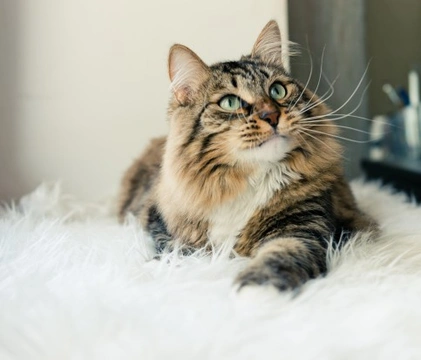
Cat Losing Hair in Clumps? Causes & Solutions
Cats can lose their fur in clumps for many reasons which could include them being fed a poor diet and one that doesn't contain the right nutrients they need to keep their coats healthy. However, you need to bear in mind that at certain times of the year, a cat will shed more of their hair than at other times. This is typically in the spring and then again in the autumn but if you find your beloved moggy is losing their fur excessively all the time – then something more amiss may be going on which would need a correct diagnosis from your vet.
How Diet Can Affect Your Cat's Coat
A poor diet or feeding your cat a bad quality pet food can seriously affect the condition of their skin and therefore their coats. Cats need all sorts of nutrients and if there are insufficient levels in their diet, this could result in a poor looking coat. However, diet alone may not be an issue because some diseases are known to prevent a cat from absorbing these valuable nutrients, vitamins and minerals which means your vet would need to advise you on what course of action to take – this could include vitamin injections being given to your cat on a regular basis throughout their lives.
A Condition Known as Stud Tail
If you find that your cat has a moist, waxy patch at the base of their tales, this could be because they have developed a condition known as "stud tail". It's a disorder that is also called feline tail gland hyperplasia and is caused by a problem in your pet's sebaceous gland. The normal secretion from this gland is interrupted which causes a build-up. The condition is more commonly seen in neutered male cats although poor hygiene could also be the root cause of the problem too. This is when bacteria growth takes over and although the condition looks bad, it is more cosmetic than a real health issue.
You would need to keep an eye out and if there is a build-up of secretions, you would need to make sure your cat is correctly groomed and washed routinely to keep on top of the condition. If you are unsure, you should discuss the problem with your vet.
Parasites Can be a Real Problem
Flea infestations, mites and ticks can also be a real issue which needs to be addressed as soon as possible. You should think about putting a flea collar on your cat but only if you are sure they are not going to catch it on anything. It might be better to invest in a topical flea treatment which are very effective at keeping these nasty creatures at bay. A cat with a flea or mite problem will scratch themselves incessantly causing sores on their bodies which could result in loss of hair.
Ringworm is a Real Issue
Your cat may have caught ringworm which is a fungal skin infection and nothing to do with worms whatsoever. The symptoms to watch out for include hair loss, very dry skin and irritation with rashes appearing which get worse because your cat keeps scratching at them. You would need to treat the condition with a specifically formulated ringworm treatment for cats. However, you should discuss the problem with your vet who would be able to recommend or prescribe an effective topical treatment that would work faster than over-the-counter treatments.
Could Your Cat be Suffering from Allergies?
You may find that your beloved feline friend is suffering from some sort of allergy and that the problem is not an infestation or infection at all. A visit to the vet would determine whether this is the case or not. Some cats develop allergies to certain foods or their environments. Your vet would need to carry out some tests to find out if the allergy is food related or a problem with allergens in your home or even outdoors as pollen could be a problem too. Once this has been established, you would then do everything to make sure you eliminate the causes and therefore reduce the risk of your cat suffering an allergic reaction.
Other Things Which Could Cause the Problem
Certain chemicals and fire retardant products could also be the culprits for cats losing their hair which is why it is so important to keep any of these products well away from your little feline friend. Better still, try to use chemical-free products on your garden and in your home – these are much better for the environment too and the wildlife that might visit your garden.
Conclusion
At the end of the day, you would need to take your cat to the vet if you notice they are losing an excessive amounts of hair on their bodies or on their tails. It is really important to find out the root cause of the problem before you do anything and this means a correct diagnosis being made by a qualified vet. Your vet will ask you certain questions which might include what you normally feed your cat, the type of shampoo you use and anything strange that might have happened which could have resulted in your cat losing their fur. This information together with other tests they carry out would help determine the cause of your cat's hair loss.



